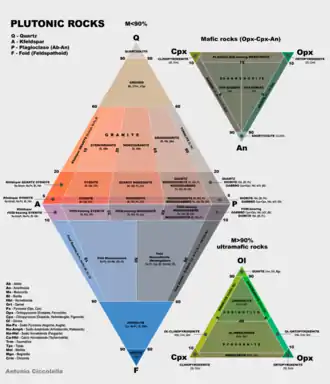QAPF diagram
A QAPF diagram is a double ternary diagram which is used to classify igneous rocks based on mineralogic composition. The acronym QAPF stands for "Quartz, Alkali feldspar, Plagioclase, Feldspathoid (Foid)". These are the mineral groups used for classification in QAPF diagram. Q, A, P and F percentages are normalized (recalculated so that their sum is 100%).


Origin
QAPF diagrams were created by the International Union of Geological Sciences (IUGS): Subcommission on the Systematics of Igneous Rocks[1] fostered by Albert Streckeisen (whence their alternative name: Streckeisen diagrams). Geologists worldwide accept the diagrams as a classification of igneous, especially plutonic rocks.
Usage
QAPF diagrams are mostly used to classify plutonic rocks (phaneritic rocks), but are also used to classify volcanic rocks if modal mineralogical compositions have been determined. QAPF diagrams are not used to classify pyroclastic rocks or volcanic rocks if modal mineralogical composition is not determined, instead the TAS classification (Total-Alkali-Silica) is used. TAS is also used if volcanic rock contains volcanic glass (such as obsidian). QAPF diagrams are also not used if mafic minerals make up more than 90% of the rock composition (for example: peridotites and pyroxenites).
An exact name can be given only if the mineralogical composition is known, which cannot be determined in the field.
Reading QAPF diagram
The QAPF diagram utilizes four minerals, or mineral groups, to classify igneous rocks. These minerals are quartz (Q), Alkali feldspars (A), plagioclase feldspars (P), and feldspathoids (F). F and Q cannot form in plutonic rocks simultaneously due to the difference in their respective silica contents. Other minerals may occur in samples, but they are not utilized by this classification method.
The QAPF diagram is composed of two ternary plots (QAP and FAP) joined along one side. To use this classification method, the concentration (the mode) of these minerals must be determined and normalized to 100%. For example: a plutonic rock that contains no alkali feldspar and no feldspathoids, but contains many pyroxenes (unlabeled in QAPF diagram), plagioclase-feldspar, and few quartz grains is probably gabbro (located at the right edge of the diagram, near P). This diagram makes no distinction between rock types of the same chemical composition in QAPF, but different chemical compositions with respect to other minerals (such as gabbro, diorite, and anorthosite).
The QAPF diagram is not used for all plutonic rocks; ultramafic plutonic rocks are the most important group that have separate classification diagrams.
References
- Streckeisen, A. (1974). "Classification and Nomenclature of Plutonic Rocks: Recommendations of the IUGS Subcommission on the Systematics of Igneous Rocks". Geologische Rundschau. 63 (2): 773–786. Bibcode:1974GeoRu..63..773S. doi:10.1007/BF01820841.
- Streckeisen, A. L., 1978. IUGS Subcommission on the Systematics of Igneous Rocks. Classification and Nomenclature of Volcanic Rocks, Lamprophyres, Carbonatites and Melilite Rocks. Recommendations and Suggestions. Neues Jahrbuch für Mineralogie, Abhandlungen, Vol. 141, 1–14.
- Le Maitre,R.W. 2002. Igneous Rocks: A Classification and Glossary of Terms : Recommendations of International Union of Geological Sciences Subcommission on the Systematics of Igneous Rocks. Cambridge University Press, 236pp.
External links
- Classification of Igneous Rocks - IUGS Classification, Geological Sciences Department - Cal Poly Pomona, archived from the original on 30 September 2011
Footnotes
- See for example the diagram as it appears in Streckeisen, Albert (July 1974). "Classification and nomenclature of plutonic rocks recommendations of the IUGS subcommission on the systematics of Igneous Rocks". Geologische Rundschau. 63 (2): 773–786. Bibcode:1974GeoRu..63..773S. doi:10.1007/bf01820841.
| Wikimedia Commons has media related to QAPF diagram. |
